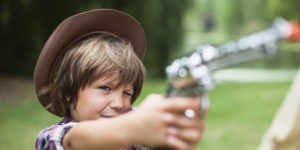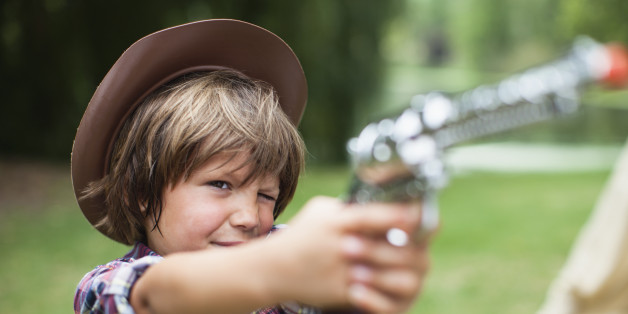
I grew up in a rural area and most people I know own guns. I myself own them, including a small rifle which we use to deal with rabid animals. This gun is not an automatic, it requires cocking each time you want to shoot, making accidental firing almost impossible. The other gun we have is an air rifle that we use to shoot small pellets at deer, mostly to keep the deer out of our garden. This pellet gun is not powerful enough to pierce hide, so it doesn’t hurt the deer, it just encourages them to leave the cucumbers alone. In both cases, the gun has a purpose, and that is exactly the purpose we put them to.
When our son was little, we, like many parents our age, were determined that our son would grow up not being exposed to guns. When he was four, I found him in our back yard with a piece of wood and a stone with a sharp edge. “What are you doing,” I asked him. “Making a gun,” he told me. I have no idea where he learned about guns as he had never seen the ones that we had – they were stored on a top shelf in my husband’s office, and when our son was older I asked him if he knew where we kept the guns. It turned out that he wasn’t aware that we even had the two guns. So, I gave him every Nerf gun he wanted and made targets at which he could shoot. He aimed at his dog once and the dog growled at him and we took the toys away for a week, as we had made a big deal about not aiming the toys at living creatures. As an adult, he has gone to shooting ranges and tried various weapons, but has decided that he isn’t interested in shooting as a sport.
If what I read in the paper is true, this is not the experience of a great many young people. They are unfamiliar with guns until they lose their tempers and try to use the gun to settle an argument. The result is all too frequently that one of the combatants dies and the other’s life is ruined. A group of people in Chicago are very concerned about this and have started a program to help young people learn to deal with their emotions in a more positive way.
This program, called de-escalation training, uses a two-pronged approach to help young people learn to find non-violent approaches to solving problems. The first step is to use scenarios to illustrate how situations that started calmly can quickly spiral out of control. For example, a cop stops a young woman driving a car for a minor infraction. She goes for her purse to get her license and the purse slips to the floor. She leans down and the cop thinks she is reaching for a gun and the situation gets out of control. Watching the scenarios, the participants in these workshops develop some understanding of how easily a situation can escalate from nothing to a major conflict based on assumptions and fears.
The second step is based on neuroscience. One of the effects of an extremely stressful situation is adrenaline flooding where the body goes into hyper-drive and the brain does not function clearly. The result is, all too frequently, a reaction that is far in excess of a reasonable response to the situation. What the workshop participants learn is how to distract someone so that they begin to think about something else and their brain can calm down. Something as simple as asking whether the person prefers mustard on their ice cream can get them to disengage. The participants also learn to use deep breathing techniques that will trigger the relaxation response or, at the very least, helps them learn to back off.
This is a new program, but one which is based on good science and good learning principles. Many young people respond when they are provoked because they have not learned any other responses and because they believe that they need to stand up for themselves. The scenarios help them understand that many of the assumptions that they have about standing up for themselves are not correct and that the best solution may be to back down. The man who can control himself will survive and that is far more important than making a point about a pair of shoes (for some reason, a common source of conflict)
Help your son by talking about situations that he sees on TV or in real life. Discuss what the real issue is and help him realize that fighting over something as silly as a pair of shoes is not worth losing one’s life. Then help him learn to recognize in himself when he is responding too quickly and too physically to a perceived threat. Training in martial arts has helped many young men learn self-control. Most of all, make sure your son knows you are more interested in him than anything that he has. Make sure he knows what is important – his survival.
